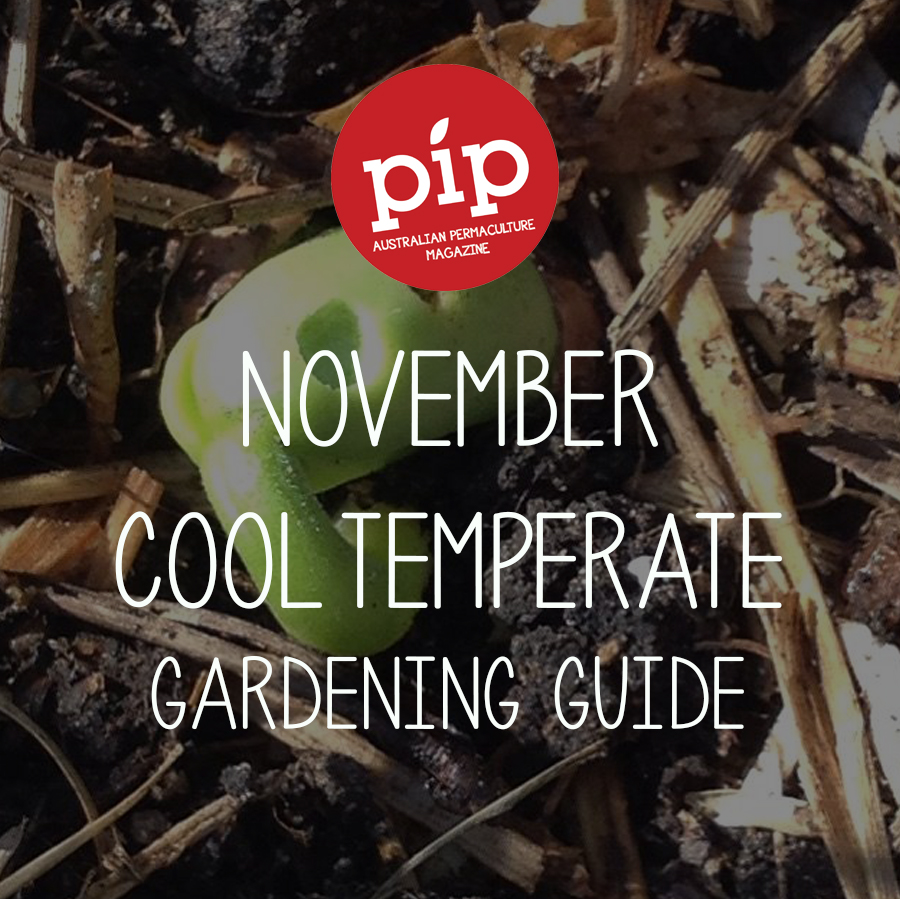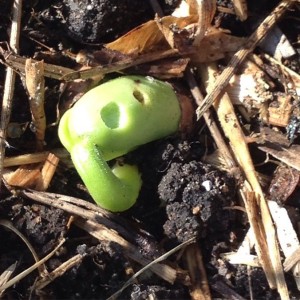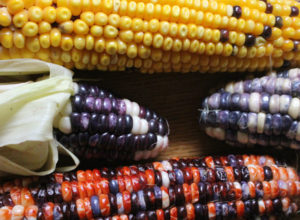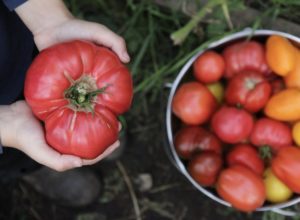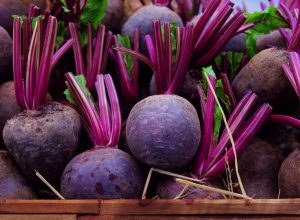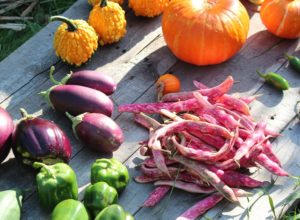November in the cool temperate garden
by Christina Giudici, Hobart, TAS of Food In My Back Yard
WHAT TO PLANT?
Pretty much all the summer vegies are good to go now that November is underway and the soil has warmed up well. As you clear out broad beans and peas, in go hungry things like sweet corn, zucchini, pumpkin, cucumber – they’ll all appreciate the nitrogen enriched legacy of the legumes.
Garlic will be coming out soon, if not already, and you can use the space to start sequential plantings of lettuce, rocket, Asian greens, carrots, beetroot, celery, silver beet, leeks, and salad onions.
Keeping potatoes such as Kennebecs are often planted around now, just as the first “bandicooted” harvest of early Spring planted pinkeyes are starting to make me drool.
And beans beans beans: bush beans and climbers of all colours, shapes and stripes can go in. Be aware that climbing beans usually take much longer to germinate and appear, so don’t despair if they seem to have forgotten to wake up. They need a good watering at the time of planting, but then nothing more until they emerge.
MAINTAINANCE
If you’re inclined to exert control and create order in your vegie patch, you can start pinching the lateral shoots out of climbing tomato plants as they grow. Climbing toms should be tied up to a stake or woven around a vertical string or encouraged to weave through a mesh trellis.
If you’re more of a ‘laisser faire’ gardener you can just let a tomato jungle develop. The down side of this is that some fruit will end up sitting on the ground, and may be attached by slugs or earwigs.
In sweet corn patches, you can deal with weeds by laying down wet newspaper between the plants, and covering with a thick layer of mulch materials such as compost, old straw, or even weeds that you have just pulled out. The mulch layer can help buttress the corn stalks, and the corn may even put out roots to get extra nutrition from this layer.
For fruit growers, thin out crowded clusters of apples and pears for larger fruit.
PESTS AND DISEASE
Keep checking your codling moth traps to see what the population is doing.
Slugs love to demolish newly planted cucurbits, so try sprinkling crushed eggshells or coffee grounds around new pumpkin, zucchini or cucumber seedlings. We have a blackbird problem in our garden, so we “cage” each new seedling with a wire cylinder, and this allows us to sprinkle a few snail bait pellets inside the cage where the birds can’t get them.
Late crops of garlic may develop rust – simply cut off affected leaves, or pull the lot when ready.
Similarly, late pea crops may develop mildew quite badly – just harvest what you can and consign the rest to the compost heap. Free pea straw!
HARVEST AND PRESERVE
Garlic planted in April / May is usually ready to harvest in November or early December. If you have planted hardneck garlic, which gets a flower stalk, you will notice curly whimsical stalks with a little bump near the end (scapes) emerging this month. Scapes are delicious chopped and stir fried, or brushed with oil and grilled, or made into a heavenly pesto.
To check if garic bulbs are ready to harvest, pull a big one up and slice it through the middle horizontally. Check to see if the cloves have fully segmented. The aim is to leave it in the ground as long as possible, but before the outer papery layers of skin around the whole head start to crack and let soil in.
Once you’re ready to pull the lot, try to wait till there has been a dry spell. Spread the harvested bulbs out in an airy spot out of the rain (we use our veranda) and turn them over each day for a week or so. Then strip a few leaves off to get nice clean heads. Now plait or bundle up your bounty, and hang somewhere dry and cool (not cold) for keeping.
PERMACULTURE PRINCIPLE NO 10: Use edges and value the marginal
Edges offer valuable diversity in a garden.
In summer, the shade on the southern side of a bed growing tall things like corn or climbing beans or tomatoes can be a perfect spot for lettuce, which don’t like really hot summer sun.
Berries such as currants, gooseberries, raspberries and blueberries will all tolerate some shade too, and are a great edge understorey next to larger orchard fruit trees.
A further layer again can be strawberries, nestled at the edge of the berries (which are nestled at the edge of the orchard). Especially when other berries or fruit trees are newly planted, a groundcover of strawberries for a few years can make use of the well-mulched space.
Pathway edges are perfect for things that you need to pick regularly. Parsley and chives both can manage quite narrow spaces next to paths, and we’ve all seen that there is nothing so tough as a self-seeded parsley plant growing in a crack in the paving!
Comfrey is a terrific edge – dweller, especially in a partially protected border around the inside of a chook run. The chickens can peck at the leaves through a tunnel or arch of wire mesh, and the tough comfrey plants can absorb any extra nutrients that might otherwise run-off from the chook yard. Comfrey will potentially spread out beyond the fence on the outside however, so consider carefully before planting!

